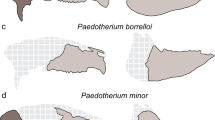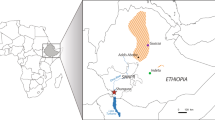Abstract
The objective of this study is to estimate changes in feeding preferences of the proboscidean species Gomphotherium subtapiroideum (Schlesinger 1917) by means of dental microwear analyses. The dietary changes are first evaluated through the ontogeny of this species, between juveniles and adults, and are then studied through geological time, from early Middle Miocene (MN5) to middle Late Miocene (MN8–9) localities of the German Molasse Basin. The microwear patterns of juvenile and adult individuals of G. subtapiroideum from Sandelzhausen (MN5) differ merely by the variable “length of scratches”, emphasizing longer jaw movements during mastication in adults. The microwear signatures of G. subtapiroideum do not vary significantly between the two geological time periods studied, but reflect mixed feeding preferences in both cases. These results imply that, despite an important environmental change at that time (drying and opening), the ecology of G. subtapiroideum and, especially, its feeding habits were not affected. Its dental microwear pattern is then compared with those of other species of Proboscidea from the Middle-Late Miocene of Germany, namely Deinotherium giganteum and Gomphotherium steinheimense.
Kurzfassung
Die vorliegende Untersuchung hat das Ziel anhand von „Microwear”-Analysen an Backenzähnen eventuelle Veränderungen von Futterpräferenzen der Rüsseltierart Gomphotherium subtapiroideum (Schlesinger 1917) abzuklären. Hierbei werden eventuelle innerartliche Veränderungen zum einen im Laufe der Ontogenie, also zwischen juvenilen und adulten Tieren, zum anderen im Laufe der Zeit vom frühen Mittel-Miozän (MN5) zum mittleren Ober-Miozän (MN8–9), basierend auf Material von Fundstellen aus dem deutschen Molassebecken, ausgewertet. Das „Microwear”-Muster von G. subtapiroideum aus Sandelzhausen (MN5) zeigt keine nennenswerten Unterschiede zwischen juvenilen und adulten Individuen, außer für die Länge der Kratzer, die wohl von längeren Kieferbewegungen bei adulten Tieren herrühren. Die „Mircowear”-Signatur von G. subtapiroideum lässt auch keine wesentliche Veränderung zwischen den beiden, untersuchten geologischen Zeiten erkennen; in beiden Fällen ist das Signal typisch für „mixed-feeder”. Dieses Ergebnis spricht dafür, dass, obwohl in diesem Zeitraum eine nicht unwesentliche Veränderung zu einer allgemein trockeneren und offeneren Umwelt statt gefunden hat, dies keinen Einfluß auf die Lebensweise und das Nahrungsverhalten von G. subtapiroideum hatte. Des Weiteren wird das „Microwear”-Muster von G. subtapiroides mit denen anderer mittel-/obermiozäner Rüsseltiere, nämlich Deinotherium giganteum und Gomphotherium steinheimense, verglichen.



Similar content being viewed by others
References
Blake, S. 2002. Forest buffalo prefer clearings to closed-canopy forest in the primary forest of northern Congo. Oryx 36(1): 81–86.
Boisserie, J.-R., A. Zazzo, G. Merceron, C. Blondel, P. Vignaud, A. Likius, H.T. Mackaye, and M. Brunet. 2005. Diet of modern and late Miocene hippopotamids: evidence from carbon isotope composition and micro-wear of tooth enamel. Palaeogeography, Palaeoclimatology, Palaeoecology 221: 153–174.
Calandra, I., U.B. Göhlich, and G. Merceron. 2008. How could sympatric megaherbivores coexist? Example of niche partitioning within a proboscidean community from the Miocene of Europe. Naturwissenschaften 95(9): 831–838.
Charles, C., J.-J. Jaeger, J. Michaux, and L. Viriot. 2007. Dental microwear in relation to changes in the direction of mastication during the evolution of Myodonta (Rodentia, Mammalia). Naturwissenschaften 94: 71–75.
Codron, D., J. Codron, J.A. Lee-Thorp, M. Sponheimer, D. de Ruiter, J. Sealy, R. Grant, and N. Fourie. 2007. Diets of savanna ungulates from stable carbon isotope composition of faeces. Journal of Zoology 273(1): 21–29.
Conover, W.J., and R.L. Iman. 1981. Rank transformations as a bridge between parametric and nonparametric statistics. The American Statistician 35: 124–129.
Dehm, R. 1955. Die Säugetier-Faunen in der Oberen Süßwassermolasse und ihre Bedeutung für die Gliederung. In Erläuterungen zur Geologischen Übersichts-Karte der Süddeutschen Molasse 1:300,000, ed. Bayerisches Geologisches Landesamt, 81–88. München: Bayerisches Geologisches Landesamt.
Doppler, G., T. Pürner, and M. Seidel. 2000. Zur Gliederung und Kartierung der Bayerischen Vorlandmolasse. Geologica Bavarica 105: 217–241.
Eronen, J.T., and G.E. Rössner. 2007. Wetland paradise lost: Miocene community dynamics in large herbivorous mammals from the German Molasse basin. Evolutionary Ecology Research 9: 471–494.
Estes, R.D. 1991. The behaviour guide to African mammals. Berkeley: University of California Press.
Fox, D.L., and D.C. Fisher. 2004. Dietary reconstruction of Miocene Gomphotherium (Mammalia, Proboscidea) from the great plains region, USA, based on the carbon isotope composition of tusk and molar enamel. Palaeogeography, Palaeoclimatology, Palaeoecology 206: 311–335.
Fritz, H.P., P. Duncan, I.J. Gordon, and A.W. Illius. 2002. Megaherbivores influence trophic guilds structure in African ungulate communities. Oecologia 131: 620–625.
Gagnon, M., and A.E. Chew. 2000. Dietary preferences in extant African Bovidae. Journal of Mammalogy 81(2): 490–511.
Göhlich, U.B. 1999. Order Proboscidea. In The Miocene land mammals of Europe, ed. G.E. Rössner, and K. Heissig, 157–168. München: Pfeil.
Göhlich, U.B. 2010. This volume. The Proboscidea (Mammalia) from the Miocene of Sandelzhausen (southern Germany). In Fossil lagerstätte Sandelzhausen (Miocene, southern Germany): Contributions to the fauna II, Paläontologische Zeitschrift 84 (1), eds. G.E. Rössner, and U.B. Göhlich. doi:10.1007/s12542-010-0053-1
Goillot C., C. Blondel, and S. Peigné. 2009. Relationships between dental microwear and diet in Carnivora (Mammalia)—Implications for the reconstruction of the diet of extinct taxa. Palaeogeography, Palaeoclimatology, Palaeoecology 271:13–23.
Gomes Rodrigues H., G. Merceron, and L. Viriot. 2009. Dental microwear patterns of extant and extinct Muridae (Rodentia, Mammalia): ecological implications. Naturwissenschaften 96:537–542.
Green, J.L., G.M. Semprebon, and N. Solounias. 2005. Reconstructing the palaeodiet of Florida Mammut americanum via low-magnification stereomicroscopy. Palaeogeography, Palaeoclimatology, Palaeoecology 223(1–2): 34–48.
Grine, F.E. 1986. Dental evidence for dietary differences in Australopithecus and Paranthropus: a quantitative analysis of permanent molar microwear. Journal of Human Evolution 15: 783–822.
Heissig, K. 1989. The faunal succession of the Bavarian Molasse reconsidered–correlation of the MN5 and MN6 faunas. In European Neogene mammal chronology, ed. E.H. Lindsay, V. Fahlbusch, and P. Mein, 181–192. New York: Plenum Press. (NATO ASI Series (A)).
Heissig, K. 1997. Mammal faunas intermediate between the reference faunas of MN4 and MN6 from the upper freshwater Molasse of Bavaria. In Actes du Congrès BiochroM’97, ed. J.-P. Aguilar, S. Legendre, and J. Michaux, 609–618. Montpellier: Mémoires et Travaux de l’E.P.H.E.
Hofmann, R.R., and D.R.M. Stewart. 1972. Grazer or browser: a classification based on the stomach structure and feeding habits of East African ruminants. Mammalia 36: 226–240.
Kay, R.F. 1975. The functional adaptations of primate molar teeth. American Journal of Physical Anthropology 43: 195–206.
Kay, R.F. 1977. The evolution of molar occlusion in the Cercopithecoidea and early Catarrhines. American Journal of Physical Anthropology 46: 327–352.
Kaup, J. 1829. Neues Säugethier, Deinotherium: Deinotherium giganteum. Isis 22: 401–404.
Kay, R.F., and R.K. Hiiemae. 1974. Jaw movement and tooth use in recent and fossil primates. Journal of Human Evolution 40: 227–256.
Kingdon, J. 1997. The Kingdom field guide of African mammals. Princeton: Princeton University Press.
Klähn, H. 1922. Die badischen Mastodonten und ihre süddeutschen Verwandten. Berlin: Gebrüder Borntraeger
Koufos, G.D., G. Merceron, D.S. Kostopoulos, I.A. Sylvestrou, and T.D. Vlachou. 2006. The late Miocene vertebrate locality of Perivolaki, Thessaly, Greece. Palaeoecology and Palaeobiogeography. Palaeontographica A 276: 201–221.
Leuthold, B.M., and W. Leuthold. 1972. Food habits of giraffe in Tsavo National Park, Kenya. East African Wildlife Journal 10: 129–141.
MacFadden, B.J., N. Solounias, and T.E. Cerling. 1999. Ancient diets, ecology, and extinction of 5-million-year-old horses from Florida. Science 283: 824–827.
Merceron, G., C. Blondel, M. Brunet, S. Sen, N. Solounias, L. Viriot, and É. Heintz. 2004. The late Miocene paleoenvironment of Afghanistan as inferred from dental microwear in artiodactyls. Palaeogeography, Palaeoclimatology, Palaeoecology 207: 143–163.
Merceron, G., C. Blondel, L. de Bonis, G.D. Koufos, and L. Viriot. 2005. A new method of dental microwear analysis: application to extant primates and Ouranopithecus macedoniensis (Late Miocene of Greece). Palaios 20: 551–561.
Merceron, G., E. Schulz, L. Kordos, and T.M. Kaiser. 2007a. Paleoenvironment of Dryopithecus brancoi at Rudabánya, Hungary: evidence from dental meso- and micro-wear analyses of large vegetarian mammals. Journal of Human Evolution 53: 331–349.
Merceron, G., C. Blondel, L. Viriot, G.D. Koufos, and L. de Bonis. 2007b. Dental microwear analysis on bovids from the Vallesian (Late Miocene) of the Axios Valley in Greece: reconstruction of the habitat of Ouranopithecus macedoniensis (Primates, Hominoidea). Geodiversitas 29: 421–433.
Nelson, S., C. Badgley, and E. Zakem. 2005. Microwear in modern squirrels in relation to diet. Palaeontologia Electronica 8(1): 1–15.
Pellew, R.A. 1983. The giraffe and its food resource in the Serengeti. I. Composition, biomass and production of available browse. African Journal of Ecology 21: 241–267.
Schlesinger, G. 1917. Die Mastodonten des k.k. Naturhistorischen Hofmuseums. Denkschriften des Naturhistorischen Hofmuseums Wien. Geologisch- Paläontologische Reihe 1: 1–230.
Semprebon, G.M., L.R. Godfrey, N. Solounias, M.R. Sutherland, and W.L. Jungers. 2004. Can low-magnification stereomicroscopy reveal diet? Journal of Human Evolution 47: 115–144.
Shoshani, J., and J.F. Eisenberg. 1982. Elephas maximus. Mammalian Species 182: 1–8.
Shoshani, J., and P. Tassy. 2005. Advances in proboscidean taxonomy & classification, anatomy & physiology, and ecology & behavior. Quaternary International 126–128: 5–20.
Sokal, R.R., and F.J. Rohlf. 1995. Biometry: the principles and practice of statistics in biological research. New York: W. H. Freeman & Co.
Solounias, N., M.F. Teaford, and A. Walker. 1988. Interpreting the diet of extinct ruminants: the case of a non-browsing giraffid. Palaeobiology 14: 287–300.
Solounias, N., and G. Semprebon. 2002. Advances in the reconstruction of Ungulate ecomorphology with application to early fossil Equids. American Museum Novitates 3366: 1–49.
Teaford, M.F., and A. Walker. 1984. Quantitative differences in dental microwear between primate species with different diets and a comment on the presumed diet of Sivapithecus. American Journal of Physical Anthropology 64: 191–200.
Ungar, P.S. 1996. Dental microwear of European Miocene catarrhines: evidence for diets and tooth use. Journal of Human Evolution 31: 335–366.
Walker, P.L. 1976. Wear striations on the incisors of ceropithecoid monkeys as an index of diet and habitat preference. American Journal of Physical Anthropology 45(2): 299–307.
Walker, A., H.N. Hoeck, and L. Perez. 1978. Microwear of mammalian teeth as an indicator of diet. Science 201: 908–910.
Acknowledgments
We are grateful to T. Kaiser and E. Schulz for discussions. IC thanks S. Legendre, G. Escarguel (Univ. Lyon, France), and the Ecole Normale Supérieure of Lyon and the Office Franco-Allemand pour la Jeunesse for financial support. UG was financed by a Habilitation-Fellowship (Hochschul-Wissenschafts-Programm, HWP) of the University of Munich. GM was supported by the Humboldt Foundation (Germany) and the Singer-Polignac Foundation (France). Finally, the authors thank G. Rössner and two anonymous reviewers for their helpful comments on an earlier version of this manuscript.
Author information
Authors and Affiliations
Corresponding author
Appendix
Appendix
Dental facet nomenclature. Occlusal views of left M2 (a, left) and right M2 (b, left) of Macaca mulatta with location of each dental facet superimposed (modified after Kay 1977). Stippled features symbolize the grinding facets that are involved in phase II of mastication. Shearing facets are hatched and are involved in the lingual and buccal chewing phases I. The shearing facets that were investigated in this study are drawn on a right M3 (BSPG 1959 II 4783; a, right) and on a left M3 (1959 II 11381; b, right) of adult of Gomphotherium subtapiroideum from Sandelzhausen. Homologous facets on the posterior loph(id)s of molars are not represented here but were also investigated in this study. Scale bars = 50 mm
Rights and permissions
About this article
Cite this article
Calandra, I., Göhlich, U.B. & Merceron, G. Feeding preferences of Gomphotherium subtapiroideum (Proboscidea, Mammalia) from the Miocene of Sandelzhausen (Northern Alpine Foreland Basin, southern Germany) through life and geological time: evidence from dental microwear analysis. Paläontol Z 84, 205–215 (2010). https://doi.org/10.1007/s12542-010-0054-0
Received:
Accepted:
Published:
Issue Date:
DOI: https://doi.org/10.1007/s12542-010-0054-0





